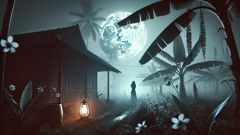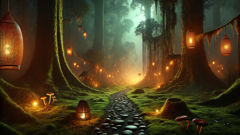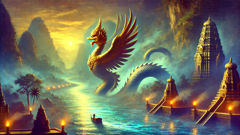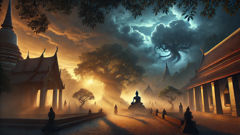Introduction
In the shadowed forests and shimmering lakes of ancient Finland, where mist clings to pine boughs and the earth hums with untold magic, legends are born from the whispers of wind and water. Among these legends, none flickers more brightly—or more perilously—than that of Lemminkäinen. Known far and wide for his wild beauty, reckless courage, and audacious heart, Lemminkäinen strode through the age of heroes as both a beloved son and a feared adversary. His name was spoken with equal measures of admiration and warning, for he was a force of nature—restless as the spring meltwaters, unpredictable as the northern lights. His tale is woven deep into the tapestry of the Kalevala, the mighty Finnish epic that pulses with the soul of its people. Lemminkäinen's story is not just one of triumph and battle; it is a chronicle of longing, loss, and the unyielding power of a mother's love. From the echoing halls of Pohjola to the dream-strewn banks of the Tuoni river, his journey traverses realms both mortal and divine. He sought the impossible, challenged fate, and paid the price—his hubris casting him down into death's cold embrace. Yet in the darkness, hope endured: a mother's hands, gentle but unwavering, defied the gods and called him back from oblivion. The legend of Lemminkäinen is, at its heart, a story of redemption. It asks what it means to fall—and what it takes to rise again. Through vivid landscapes and ancient sorcery, through love gained and lost, through defiance and deliverance, this is the tale of a man who lived loudly, lost everything, and found his soul again in the light of dawn.
The Reckless Heart: Lemminkäinen’s Rise and the Seeds of Fate
Lemminkäinen’s childhood was marked by restlessness and mischief. Born in a humble cottage on the shores of Lake Saari, he was the cherished son of Lempi, a wise woman whose knowledge of spells rivaled even the oldest shamans. Yet from his earliest days, Lemminkäinen yearned for more than quiet days and whispered charms. He longed for adventure, for glory, for tales that would echo across the land. He learned the art of song-magic at his mother’s knee, but his feet itched for distant roads and his heart burned for conquest.
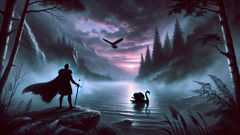
His beauty and wild spirit attracted admiration and envy in equal measure. The maidens of Saari sang songs of his golden hair and bright eyes, while young men eyed him with wariness, knowing that where Lemminkäinen walked, trouble often followed. He was quick to laughter, quicker still to anger, and never one to back down from a challenge. Tales spread of his daring hunts, his swift swordplay, and his uncanny ability to weave words into spells that could bend the wind or lull wild beasts. Yet beneath the bravado flickered a shadow—a hunger that even he could not name.
As he grew into manhood, stories of Pohjola reached his ears. Pohjola: a realm of ice and power, ruled by the sorceress Louhi. There, it was whispered, dwelled the Maiden of Pohja—fairest of all women, her hand promised only to the hero who could fulfill Louhi’s impossible demands. Lemminkäinen’s heart leapt at the prospect. What better way to win renown than to claim the hand of Pohjola’s daughter? Ignoring his mother’s pleas and the omens that trembled on the wind, he prepared for his journey. He adorned himself in fine furs and silver, gathered his gleaming sword, and set out, leaving behind the warmth of home for the uncertainty of legend.
His voyage was fraught with peril from the outset. The path to Pohjola was guarded by monsters born of frost and shadow: wolves whose howls split the night, rivers swollen with enchantment, forests so dense that day could not pierce them. But Lemminkäinen laughed in the face of danger. His sword flashed, his voice rang out in defiant song, and one by one the obstacles fell. Yet with every victory, pride grew in his heart—pride that would soon lead him to the brink.
Upon reaching Pohjola, Lemminkäinen faced Louhi herself. She was ancient and terrible, her eyes bright as winter stars. She listened to his boastful words with cool amusement and set him three impossible tasks: to hunt the demon elk of Hiisi, to bridle the monstrous wolf of Tuonela, and to fish the black swan that glided upon Death’s river. Lemminkäinen accepted without hesitation. Even as Louhi’s laughter echoed in the icy halls, he believed himself unstoppable.
The first two tasks tested him to his core. The elk led him through forests of nightmare, vanishing in shadows and reappearing in places that defied sense. Only through cunning, and a spell whispered from memories of his mother, did Lemminkäinen succeed. The wolf, a beast with eyes like molten gold, nearly tore him apart before he entranced it with a hypnotic melody. Each victory stoked his confidence—yet each left him more exhausted, more careless.
The final task would be his undoing. The black swan of Tuonela was no ordinary creature: it glided along the river that bordered the realm of the dead, where mortals were forbidden to tread. Undeterred, Lemminkäinen pressed onward. He sang spells to cloak himself, navigated waters thick with fog and sorrow, and finally glimpsed the swan’s obsidian wings.
But pride had blinded him. A lurking sentry—a vengeful shepherd of Tuonela—lay in wait. As Lemminkäinen reached for the swan, the shepherd hurled a poisoned reed, striking the hero through the heart. Death came swiftly. His body tumbled into the river’s cold embrace, vanishing beneath the black current. Far from home, far from glory, Lemminkäinen lay broken and forgotten at the edge of the world.
A Mother’s Grief: Descent to Tuonela and the Threads of Life
In Saari, Lempi awoke with a cold certainty in her bones. The air felt wrong; the wind brought no song. She knew, with the unerring instinct of a mother, that something terrible had befallen her son. Days passed without word. The hearth grew cold; the world shrank to silence. Refusing despair, Lempi gathered her charms and ventured forth, determined to find Lemminkäinen—be he alive or dead.
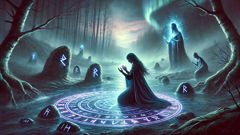
Her journey was one of sorrow and resolve. The land responded to her grief: lakes mirrored her tears, and birds fell silent as she passed. She questioned every creature she met, from foxes to ancient willows. At last, a whisper from a passing magpie led her to the realm of Tuonela, the land of the dead. The journey to Tuonela was fraught with peril even for the wise. It was a place where the sun never shone, where icy mist concealed both path and purpose. Yet Lempi pressed on, chanting spells older than memory, her resolve hardening with every step.
At the banks of the black river, she faced Tuoni, the Lord of Death. His eyes were endless night; his voice, a chill that reached the marrow. Lempi pleaded for her son’s return, offering gifts of song and tears. But Tuoni was unmoved. “None return from here,” he intoned, “save those whose kin are willing to pay any price.” Lempi would not yield. She cast her net of spells across the river, calling upon every spirit and ancestor to guide her search.
Days stretched into nights. Lempi’s strength waned, but her hope remained unbroken. At last, deep in the reeds and mud, she found what she sought: a tangle of bone and hair—the remnants of Lemminkäinen, lifeless and scattered by the river’s slow current. The sight would have broken any heart but a mother’s. Steeling herself, Lempi gathered the pieces, cleaning them with water drawn from sacred springs and tears born of love.
She laid her son’s remains upon a cloth woven with protective runes, and began her work. From her satchel she drew ancient herbs, rare stones, and a feather from the eagle that flies between worlds. She sang over each bone, weaving spells of healing and remembrance. Night after night, her voice battled the darkness, a melody of hope in a realm that had never known it. The spirits watched and murmured. Even Tuoni seemed to pause, his eternal indifference shaken by such devotion.
But death is stubborn. Though Lempi reassembled her son’s body and covered it in restorative oils and charms, Lemminkäinen’s soul hovered beyond reach—caught between worlds, unwilling or unable to return. Lempi’s voice faltered; exhaustion crept in. Yet in her deepest despair, she remembered the oldest spell of all: the call of a mother to her child. Summoning every drop of love and longing, she sang his name into the void, again and again.
The river stilled. The mists parted. And in the silence, something shifted—a heartbeat, faint but undeniable, echoed through Tuonela’s gloom. Lemminkäinen’s spirit stirred. Light flickered along his form; color returned to his lips. With a gasp that rippled through both worlds, he opened his eyes. Against all odds, Lempi had drawn him back from death itself.
Their reunion was raw with joy and pain. Lempi held her son close, her tears falling on his brow. Lemminkäinen wept as well—not for his suffering, but for the love that had conquered even Tuoni’s grip. The land itself seemed to breathe easier as they emerged from Tuonela, crossing from shadow to dawn. Yet both knew that life after death would never be the same. Lemminkäinen was changed—humbled, chastened, but alive.
Together they returned to Saari, the world brightening with every step. News of Lemminkäinen’s resurrection spread like wildfire. Where once his name had been a byword for recklessness, it now carried a different weight: a lesson in humility, and a testament to the indomitable power of a mother’s love.
Conclusion
The legend of Lemminkäinen endures not just for its adventure or tragedy, but for its deep, universal truth. To live boldly is to risk loss; to love deeply is to challenge even fate itself. Lemminkäinen’s tale is a reminder that even the mightiest can fall, that pride may bring ruin—but also that redemption is possible for those who are willing to change. His resurrection is not simply a miracle; it’s the result of a love so fierce it could bridge the gap between life and death. Across Finland’s forests and fields, parents still tell this story to their children. They speak of Lemminkäinen’s beauty and brashness, his fall and his return—not only as a warning against hubris, but as a celebration of hope. For in every heart there is the possibility of renewal, and in every loss, the seed of a new beginning. The Kalevala’s hero stands as a symbol for all who wander, all who falter, and all who rise again—called home by love that refuses to surrender.



